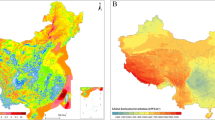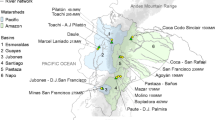Abstract
Over the years, the need for energy consumption has been increasing in all sectors of society. Consequently, discussions about renewable energy sources such as wind, solar, hydraulic and wave energy are increasingly being guided in all global environmental political discussions. More specifically, wind energy, mainly offshore, has been increasingly highlighted due to the large area to be explored. Thus, the objective of this work was to study the offshore wind profiles using five different estimation methodologies, verifying which is the best and worst scenario of wind potential. For this purpose, data from the SODAR of “Ômega Energia” located in the state of Maranhão, in the Northeast of Brazil were used; the data from the ERA5 Reanalysis and the data from the Wobben Windpower E-82 E4 wind turbine, with a nominal power of 3000 KW (3 MW). The results showed that the best method for estimating wind profiles both for this location and for the entire Northeast region of Brazil was the method using Taylor & Yelland [28] roughness estimate calculation, which considers a stable atmosphere. Comparatively, the best estimate scenario showed a gain of 0.65 MW of power generation when compared to the worst scenario.








Similar content being viewed by others
References
Arya, P.S.: Parameterizing the height of the stable atmospheric boundary layer. J. Appl. Meteor. 20, 1192–1202 (1981)
Businger, J.A., Wyngaard, J.C., Izumi, Y., Bradley, E.F.: Flux profile relationships in the atmospheric surface layer. J. Atmos. Sci. 28, 181–189 (1971)
Carmo, L.F.R., Palmeira, A.C.P.A., Antonio, C.F.J.L.: Estimation of wind profile and offshore wind potential for Cabo Frio coast. Revista S&G 15(1), 46–52 (2020)
Centro de Pesquisas em Energia Elétrica (CEPEL) (2001). Atlas de Potencial Eólico Brasileiro. Ed. CEPEL, Rio de Janeiro, RJ. http://www.cresesb.cepel.br/index.php?section=publicacoes&task=livro&cid=1. Accessed 5 Jan 2020
Chalikov, D.V.: The parametrization of the wave boudary layer. J. Phys. Oceanogr. 25, 1333–1349 (1995)
Charnock, H.: Wind stress on a water surface. Quart. J. Royal Met. Soc. 81(639), 1955 (1955)
Recommended Practice - DNV-RP-C205 (2014). Environmental Conditions and Environmental Loads.
Donelan, M. A. (1990). Air-Sea Interaction, from The Sea: Ocean Engineering Science, Volume 9 (two volume set), John Wiley & Sons
Donelan, M.A., Dobson, F.W., Smith, S.D., Anderson, R.J.: On the dependence of sea surface roughness on wave development. J. Phys. Oceanogr. 23, 2143–2149 (1993)
Dyer, A.J.: A review of flux-profile relations. Bound. Layer Meteor. 1, 363–372 (1974)
Dyrbye, C., Hansen, S.O.: Wind Loads on Structures. John Wiley and Sons, Chichester, England (1997)
Empresa de Pesquisa Energética (EPE) (2020). Perspectivas e caminhos para a energia eólica marítima, ROADMAP Eólica Offshore - Brasil. https://www.epe.gov.br/sites-pt/publicacoes-dados-abertos/publicacoes/PublicacoesArquivos/publicacao-456/Roadmap_Eolica_Offshore_EPE_versao_R2.pdf. Accessed 24 July 2020
Hansen, K.S., Barthelmie, R.J., Jensen, L.E., Sommer, A.: The impact of turbulence intensity and atmospheric stability on power deficits due to wind turbine wakes at Horns Rev wind farm. Wind Energ. 15(1), 183 (2012)
He, Y.C., Fu, J.Y., Shu, Z.R., Chan, P.W., Wua, J.R., Li, Q.S.: A comparison of micrometeorological methods for marine roughness estimation at a coastal area. J. Wind Eng. Ind. Aerodyn, 195, 104010 (2019)
Kantha, L.H., Clayson, C.A.: Small Scale Processes in Geophysical Fluid Flows, Academic Press, San Diego, 883 pp, 2000 (2000)
JCSS (Joint Committee on Structural Safety) (2001). Probabilistic Model Code, Part 2: Loads
Lange, B., Larsen, S., Højstrup, J., Barthelmie, R.: Importance of thermal effects and sea surface roughness for offshore wind resource assessment. J. Wind Eng. Ind. Aerodyn. 92(11), 959–988 (2004)
Monin, A.S., Obukhov, A.M.: Basic Laws of turbulent mixing in the atmosphere near the ground. Tr. Akad. Nauk., SSSR Geophiz. Inst, 24(151), (1954)
Montezano, B.E.M.: Modelo Dinâmico de Visualização de um Aerogerador com Velocidade de Rotação Variável e Controle de Passo em VRML. Projeto de Graduação, Departamento de Engenharia Elétrica, UFRJ, Rio de Janeiro, Brazil (2007)
Ohlenforst, K.; Sawyer, S.; Dutton, A.; Backwell, B.; Fiestas, R.; Lee, J.; Qiao, L.; Zhao, F.; Balachandran, N. (2019): Global Wind Report. Global Wind Energy Council
Panofsky, H.A., Dutton, J.A.: Atmospheric Turbulence. Models and Methods for Engineering Applications, John Wiley and Sons, New York, N.Y. (1984)
Pavinatto, E. F. (2005): Ferramenta para auxílio à análise de viabilidade técnica da conexão de parques eólicos à rede elétrica. Master Thesis., Programa de Engenharia Elétrica, COPPE/UFRJ, Rio de Janeiro, Brasil
Pichugina, Y.L., Banta, R.M., Brewer, W.A., Sandberg, S.P., Hardesty, R.M.: Doppler lidar-based wind-profile measurement system for offshore wind-energy and other marine boundary layer applications. Am. Meteorol. Soc. 51, 327–349 (2012)
Raiambal, K., Chellamuth, C. (2002). Modeling and SImulation of Grid Connected Wind Eletric Generating System, In: Proceedings of IEEE TENCON'02, pp.1847–1852
Simiu, E., Scanlan, R.U.: Wind Effects on Structures. An Introduction to Wind Engineering, John Wiley, New York, N.Y. (1978)
Sorbjan, Z.: (1991): On Similarity in the atmospheric boundary layer. Bound. Layer Meteor. 43, 377–397 (1986)
Stull, R.B.: An Introduction to Boundary Layer Meteorology. Dordrecht: Kluwer Academic Publishers, pp. 667
Taylor, P.K., Yelland, M.J.: The dependence of sea surface roughness on the height and steepness of the waves. J. Phys. Oceanogr. 31(2), 572–590 (2001)
Wyngaard, J.C.: On Surface Layer Turbulence. Workshop on Micrometeorology. (Ed. D.A. Haugen). Am. Meteoro. Soc. 101–148 (1973)
Acknowledgements
We would like to thank CENPES / PETROBRÁS who, through COPPETEC / UFRJ, provided all financial support in the development of the work and to Omega Energia for providing SODAR data for this study.
Author information
Authors and Affiliations
Corresponding author
Additional information
Publisher's Note
Springer Nature remains neutral with regard to jurisdictional claims in published maps and institutional affiliations.
Rights and permissions
About this article
Cite this article
do Carmo, L.F.R., de Almeida Palmeira, A.C.P., de Jesus Lauriano Antonio, C.F. et al. Comparison of wind profile estimation methods for calculating offshore wind potential for the Northeast region of Brazil. Int J Energy Environ Eng 13, 365–375 (2022). https://doi.org/10.1007/s40095-021-00428-7
Received:
Accepted:
Published:
Issue Date:
DOI: https://doi.org/10.1007/s40095-021-00428-7




